
Field Theory - Online Tutorial 1
by Kevin Tang , last update: Feb 23, 2014, 7.20PM (last one before midterm)
These are some important questions I think will be helpful; you can relax and read them, it can help at some level,
but what most important among all, is you must do the question by yourself at least all the homework questions and all the examples professor show in the class.
* Please think about the solution by yourself too, in case if I made any typo or mistake.
* Notice, all the bold font on this page, means that variable is a vector, for example... E
[Q1 - Electric Field Intensity Question] [ Q2 - Flux Density Question] [ Q3 - E = − ∇V Question ] [Q4 - Dielectric] [Reminder]
a) Find E at P(0,0,z), given a quarter circle of line charge density ρL along the line (the green line) shown in Figure 1.
b) Solve for the same question, where line charge forms a complete circle (i.e. φ : 0 -> 2π)
suggest solving time : 25 min

Figure . 1
SOLUTIONS 1a) (notice, my solutions is relative longer than what you need to wrote, you do not need to follow some non necessary steps)
To solve this question; first we need to processed the 5- main steps .. they are following...
Step 1 : Find r
Notice, r is where our reference point at, that is the Green Point on the z-axis
Cartesian Coordinates, we can write P as (0, 0, z) ,...
r = 0ax + 0ay + zaz
Step 2 : Find r'
Any point along that green quarter circle line in cylindrical coordinates can write as (ρ , φ, z),
ρ: where you given the constant radius as ρ = a
z: where you given the constant high z as z = z'
φ: where your only changing (non-constant) variable is φ
since in Step 1, we are already in "Cartesian Coordinates", we need to change r' into the same coordinates system - Cylindrical Coordinates,
in your formula sheet, you should able to find the equation on pages 3,...

which shows ρ aρ = ρ cos φ ax + ρ sin φ ay
ax part is ... ρ cos φ ax --> sub ρ = a in --- > a cos φ ax
ay part is ... ρ cos φ ay --> sub ρ = a in --- > a sin φ ay
az part is ... z az --> z'az az
r' = a cos φ ax + a sin φ ay + z' az
Step 3 : Find R = r − r'
r − r' = ( 0ax + 0ay + zaz ) − ( a cos φ ax + a sin φ ay + z' az )
= − a cos φ ax − a sin φ ay + (z − z') az
Step 4 : Find |R| = |r − r'|
|r − r'| = √ { (− a cos φ)2 + (− a sin φ )2 + (z − z')2 }
= √ { a2 cos2φ + a2 sin2 φ + (z − z')2 }
= √ { a2 ( cos2φ + sin2 φ ) + (z − z')2 } ... where , sin2 φ + cos2φ = 1
= √ { a2 + (z − z')2 }
and you can check your result directly by visual

based on pythagorean theorem.; the red line will have the distance ...
|r − r'| = √ { a2 + (z − z')2 }
Step 5: Find dQ
What is the change of the enclosed charge along the line, its same as the line charge destiny,
which is ρL, therefore, the dQ will be...
dQ = ρL dL
where L = ρ * φ ... the length of circlur line is same as the radius times the angle.
dL = ρ dφ ... ρ stay constant and equal to a
dL = a dφ .... now you can plug dL it back to dQ
dQ = ρL a dφ
Last Steps - Find the E
Now we have following...
(1) ... r = 0ax + 0ay + zaz
(2) ... r' = a cos φ ax + a sin φ ay + z' az
(3) ... r − r' = − a cos φ ax − a sin φ ay + (z − z') az
(4) ... |r − r'| = √ { a2 + (z − z')2 }
(5) ... dQ = ρL a dφ
Put them into the Electric Field intensity (E) equation for line...
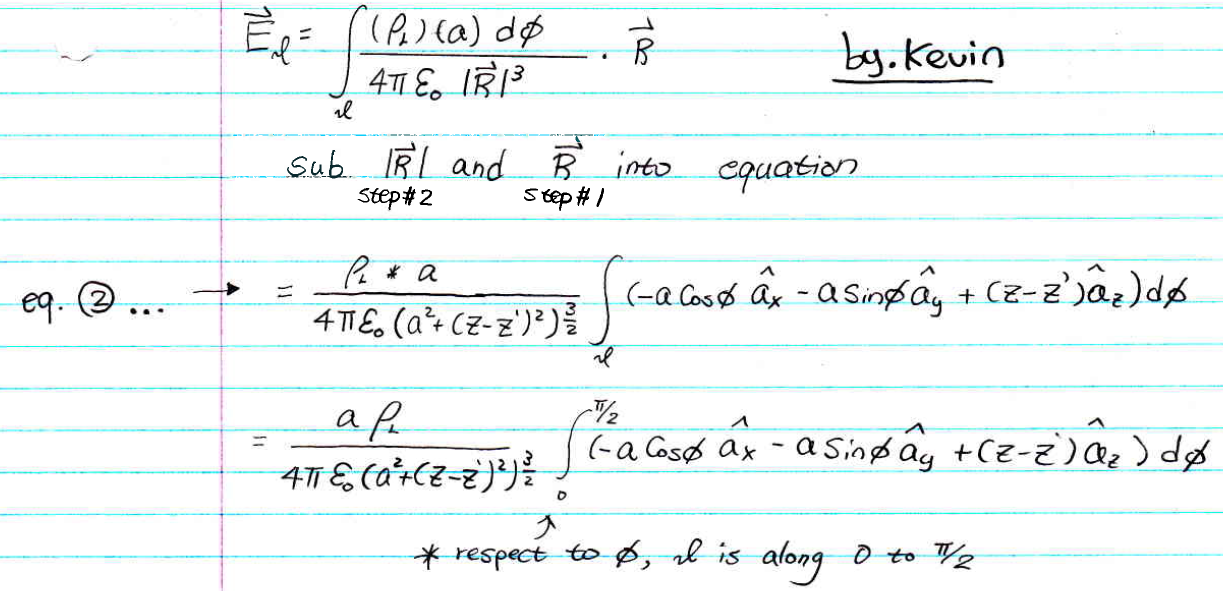

* Remember to write the unit in your final answer, the unit for E is either V/m or N/C
Q1 - b)
Solve for the same question, where line charge forms a complete circle (i.e. φ : 0 -> 2π)
SOLUTIONS 1b)
First of all, you should able to visually see the Line of that quarter circle is now forming a full circle (as I shown in Figure 2)
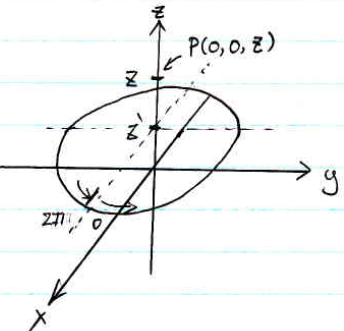
Figure 2
Noting really change, therefore, you can continue from the last steps from 1a), which we still have the following..
(1) ... r = 0ax + 0ay + zaz
(2) ... r' = a cos φ ax + a sin φ ay + z' az
(3) ... r − r' = − a cos φ ax − a sin φ ay + (z − z') az
(4) ... |r − r'| = √ { a2 + (z − z')2 }
(5) ... dQ = ρL a dφ
However, the integral boundary is changing on the φ part, instead of 0 to π/2 its now 0 to 2π.
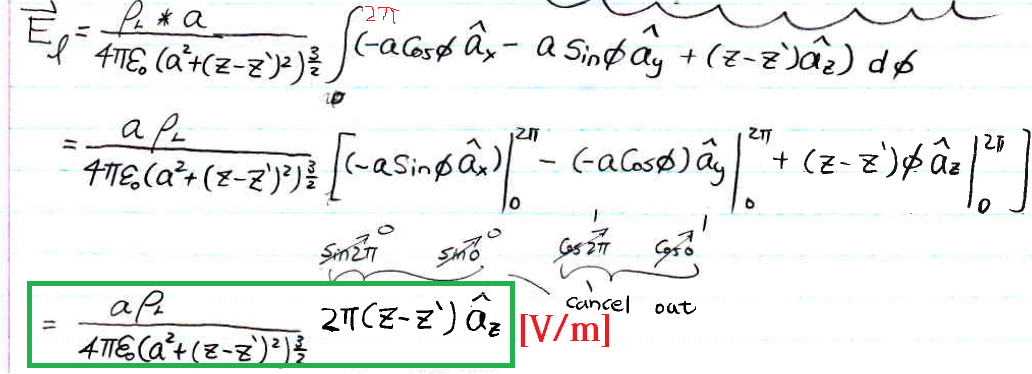
Note for 1b)
As you can double check your final answer's vector part, you can see there is only part az left,
if think visually as all the symmetric vector of Electric Field on the same plane cancel out, left only the vertical direction upward .. az
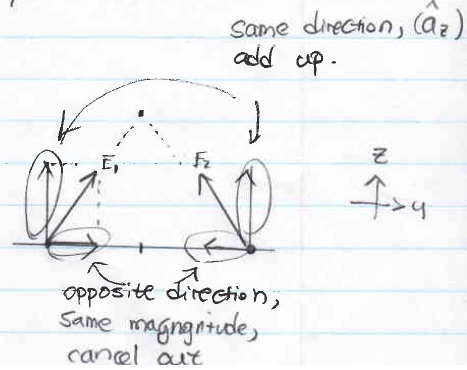
=======================================================================================================
Given a sphere with a hollow sphere inside and located at the centred at the origin, as shown in Figure 3
The hollow sphere part has a radius of "a", and the bigger sphere have the radius of "b"
if we notice the material part have the volume charge density ρv = αr [c/m3]
a) Find total charge contained in the sphere.
b) Using Gauss' law and symmetry solve for the electric flux density vector field D in the following regions
i - r <a
ii - a < r < b
iii - r > b
suggest solving time: 30 min
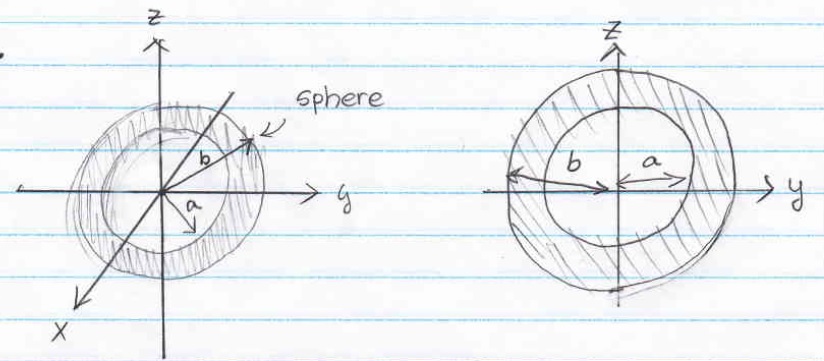
Figure . 3
SOLUTION 2a)
|
Side Knowledge. I notice some people forget this very simple relationship during the quiz 1, its sometimes happened because you think too much, just think back to what you learn in high school, you can understand easier for their relationship...
Q. Water have density of 1,000 kg/m³ , and we filled all the water in a closed sphere, which the radius is 1 [m], find the weight of this sphere in [kg].
(1) mass = density * volume (2) volume = ∫v v dv
mass = ∫∫∫ density * volume dv <--- plug density 1000 and change volume dv into sphere coordinate = ∫r=0 1 ∫θ=0π ∫φ=02π 1000 * r2 sin θ dr dθ dφ < --- r = 1 = 1000 * 4/3 π (1)3 = 4000/3 * π [kg] |
Its similar, you can see the relationship between Charge and Charge Density as following...
Qv = ∫v ρv dv ... (volume)
Qs = ∫s ρs ds ... (surface)
Ql = ∫l ρl dl ... (line)
Select the volume one,
Qenc = ∫v ρv dv
= ∫∫∫ αr * r2 sin θ dr dθ dφ <---- notice, dv = r2 sin θ dr dθ dφ in sphere coordinate.
= ∫r=a b ∫θ=0π ∫φ=02π αr3 sin θ dr dθ dφ <---- notice, as said in class, the boundary of θ cannot go over π.
and the boundary for "r" is between a and b, b/c that is where the charge is located.
= α ∫r=a b ∫θ=0π ∫φ=02π r3 sin θ dr dφ dθ < --- α is a constant, you can pulled it to the front of the integral
= α ∫r=a b r3 dr ∫θ=0π sin θ dθ ∫φ=02π dφ
= α [(1/4)r4 |r=a b][− cosθ |θ=0π][φ |φ=02π ]
= α [(1/4)(b4 − a4)][− cosπ + cos0][ 2π − 0]
= α [(1/4)(b4 − a4)][2][2π]
= απ (b4 − a4)
Answer : Qenc= απ (b4 − a4) [C]
SOLUTION 2b)
First, before you start, take a look at the volume charge density, which is ρv = αr
and this equation only applied between charged region (which is between r= a to r = b),
therefore, I can draw a equation of ρv = αr as following...
(notice, you don't have to do this on the exam).
Start with finding the enclosed charge Qenc that respect to each assigned region
i - for r < a
Similar as what we did in 2a), but the different is that this time,
the r is bounding between r= 0 to r, where r is less than a,
notice, if we are at r<a, this region, the ρv = 0, therefore, you just simply plug ρv = 0 replace with ρv
by doing so,.. you end up with D = 0 [c/m2], as shown following

ii - for a < r < b
The boundary for r is the same as from 0 to r, where r is between a and b.
The lower boundary will be a. (as shown in diagram, the lower boundary of r become "a" instead "0" since from 0 to a there are no charge)
The upper boundary will be r. (as shown in diagram, the upper boundary is r, it is a changing variable)
(common mistake, the upper boundary of "r" is NOT b, notice, r is less than b but greater than a,
therefore the upper boundary is simply a changing variable, you should write "r" on your upper boundary)
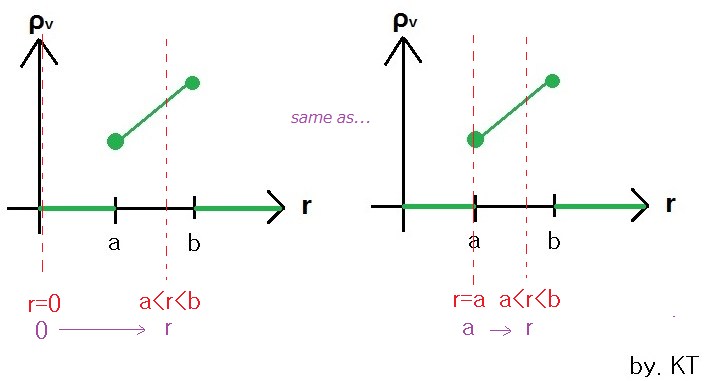
you can than wrote down Qenc for a<r<b as following.

iii - for r > b
The boundary for r is the same as from 0 to r, where r is greater than b.
The lower boundary will be a. (as shown in diagram, the lower boundary of r become "a" instead "0" since from 0 to a there are no charge)
The upper boundary will be b. (as shown in diagram, the lower boundary of r become "b" instead "r" since from b to r there are no more charge)
(common mistake, the upper boundary of "r" is NOT r, notice, r is greater than b, and if its greater than b, as you can see in diagram,
more than b, its already make charge density at full level, the upper boundary is a fixed variable as b)

you can than wrote down Qenc for r>b as following.
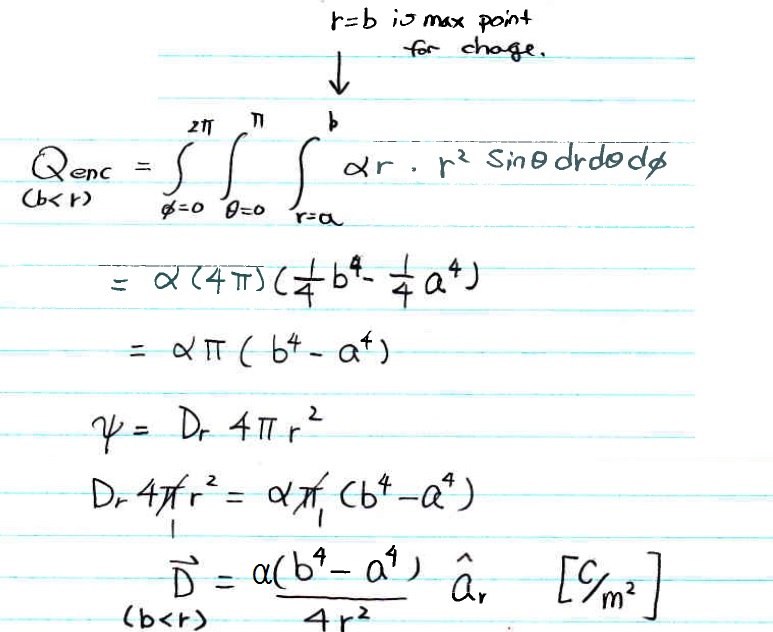
Finally, we got the D for each region as...

=======================================================================================================
Given V = Sin θ / r, find the following ...
(notice, this kind question could be V = xyz or V = ρ Cos φ ...etc ,
which are the same type question, just use different coordinate system)
a) E
b) D
c) ρv
d) Qenc with in a sphere which 0<r<1, 0<φ<90o, 0<θ<180o
suggest solving time : 15 min
SOLUTION 3)
First, you need to check which coordinate system does it belong to...
in case we have θ and r, you notice we are in "Sphere Coordinate"
a) First, write down this relationship...
E = − ∇V
|
Side Note (this is only my own suggestion, in case you forget the equation n the exam... :D) ∇V is called gradient... the gradient for sphere coordinate is not the same as in other coordinate, check your formula sheet (if you cannot remember), you should at least able to find dv relationship of all three coordinates.
the red one above is for sphere... where dv = dr r dθ r sinθ dφ each term respect to each term, ... as r, θ and φ, you can see the relationship as...
|
we got,.. ∇V = ∂/∂r V ar + (1/r) ∂/∂θ V aθ + (1/r sinθ) ∂/∂φ V aφ ... you can solved for E...
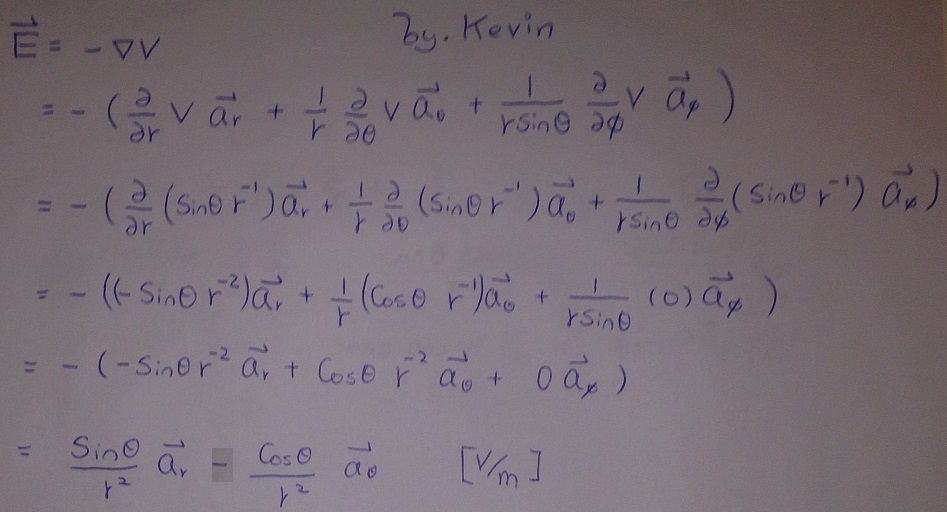
b) D = εoE

c) ρv = ∇·D
= (1/r2) ∂/∂r (r2 Dr) + (1/r sinθ)∂/∂θ (sinθ Dθ) + (1/r sinθ) ∂/∂φ Dφ
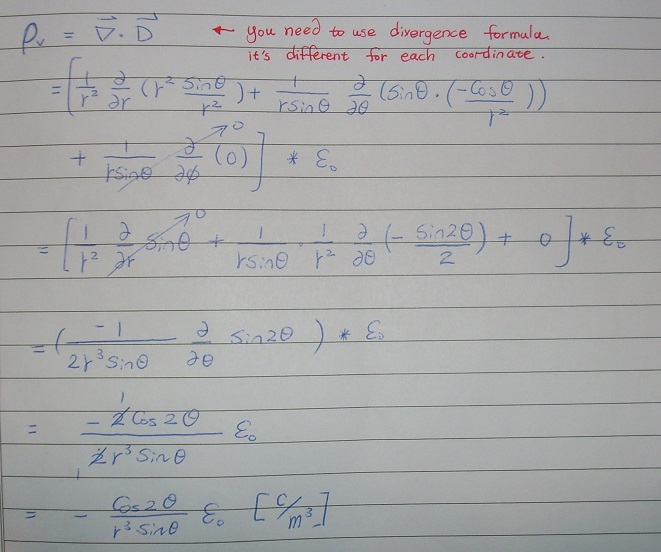
d) Qenc = ∫v ρv dv
= ∫r=0 1 ∫θ=0π ∫φ=02π ρv r2 sin θ dr dφ dθ
=======================================================================================================
A dielectric material box, have the following size, 0 < x < 2, 0 < y < k, 0 < z < 3,
the box is been placed between two conducting planes located at y = 0 and y = k.
If the polarization vector field inside the dielectric material is
P = (ny3 + m) ay [c/m2]
find the following...
a) E
b) D
c) ρs at y = 0-
d) ρs at y = k+
e) ρv
f) ρps at y = 0+
g) ρps at y = k-
h) ρpv
SOLUTION 4)
First, some student told me they didn't know dielectric is covered for the midterm,
which it is covered, so please read them, at last tutorial, we covered this question, so please review it too :)
To start with the question (I changed it),
you can draw that box out, which should be easy for you.
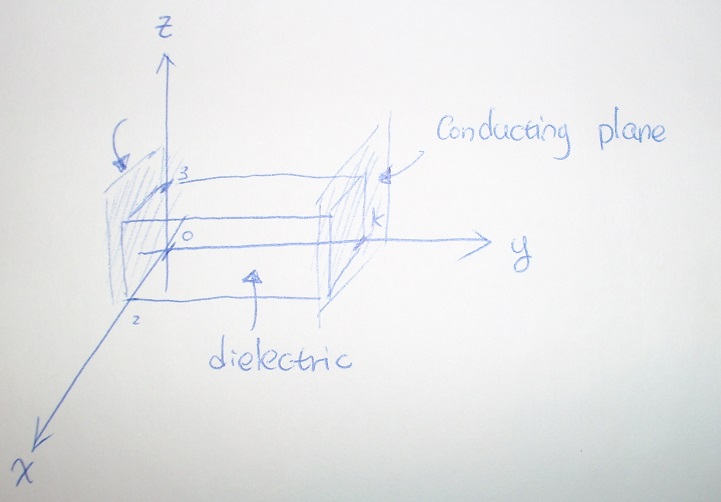
a) There are relationship between P and E, please review Chapter 5.
You need to use the following relation
P = XeεoE
where Xe = εr− 1
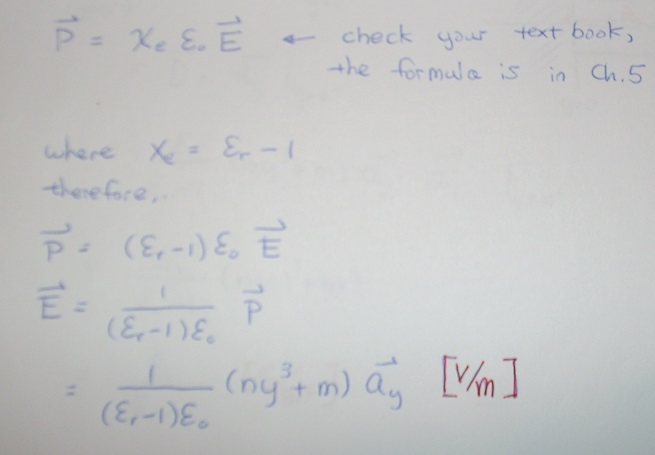
b)

c)
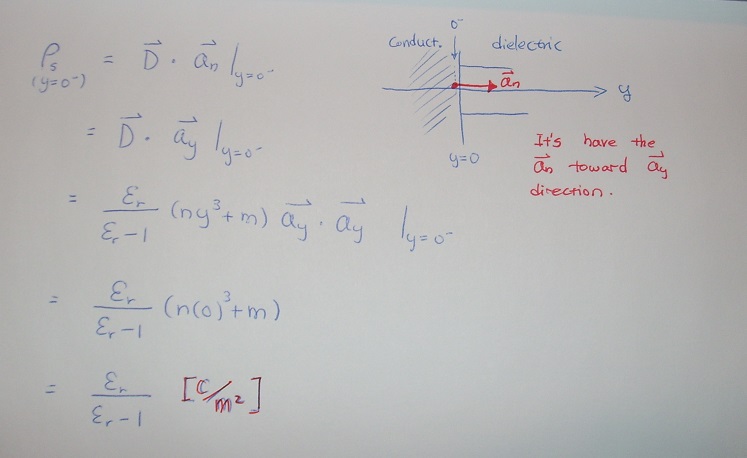
d) Same as in c
however, this time your an become −ay
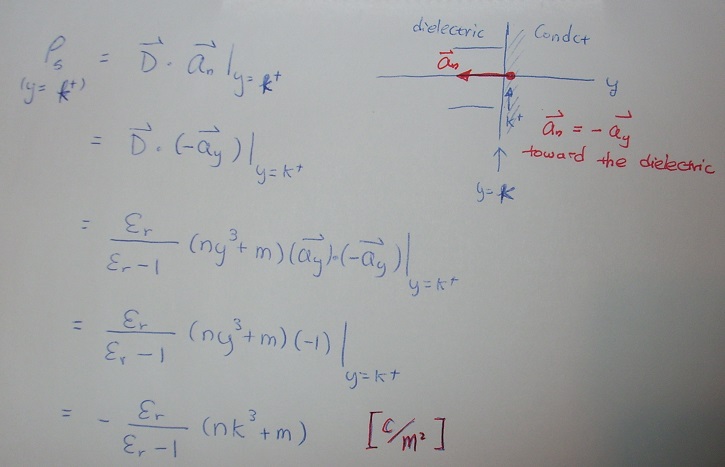
e) ρv = ∇·D
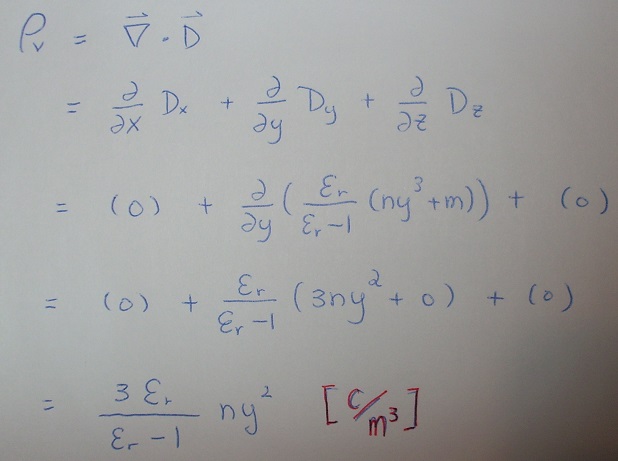
f) ρps is called polarization surface charge density, similar as what you did above
just you are looking at dielectric part instead of condt part, at y = 0+
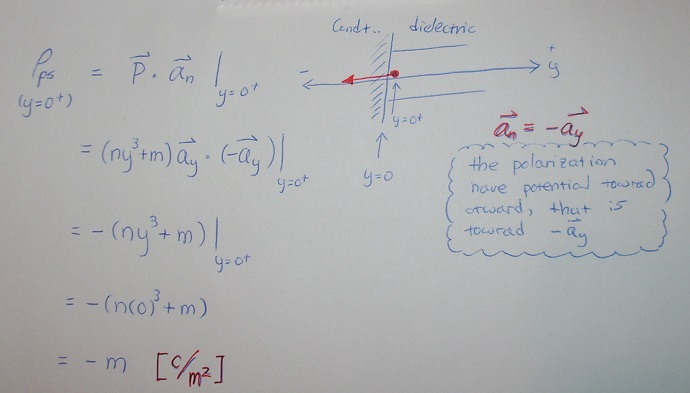
g) ρps at y = k-
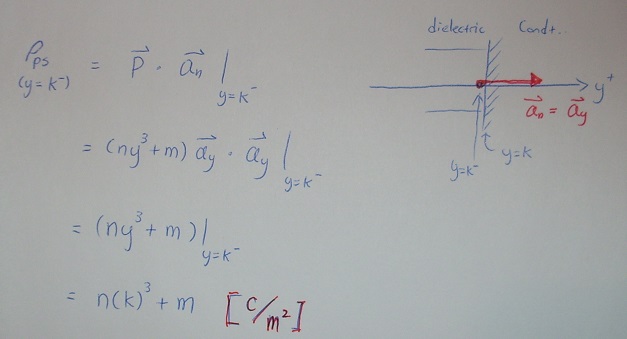
h) Very similar as you find in part e), the equation for
polarization volume charge density is ρpv = − ∇·P
=======================================================================================================
Sine some people asked, remind you,
here is how represent a point in vector form in all three coordinate
example points --->
(1, 2, 3) --> ax + 2ay + 3az
(2, 90o, 3) --- > 2aρ + 3az
(3, 90o, 195o) ----> 3ar
Don't forget few things..
Don't forget to label your x-axis, y-axis, z-axis
Don't forget the unit in your final answer
Don't forget your vector sign if you are solving for a vector
Don't forget, your formula sheet won't able to help you find all the formula you need (such as ρv = ∇·D, P = XeεoE ,... etc won't be on the formula sheet).
Don't be scared, you all passed MTH312, you can do it.
Don't forget what I said in the tutorial class,... good luck, wish you all the very best :)
You may leave me any message if you have any questions, I will try to answer ASAP, thanks and good luck :)